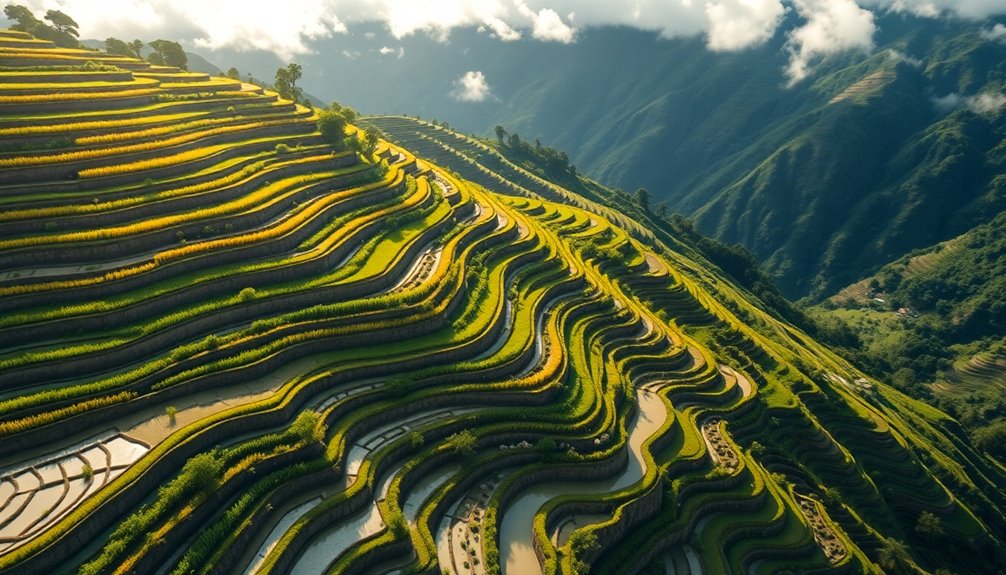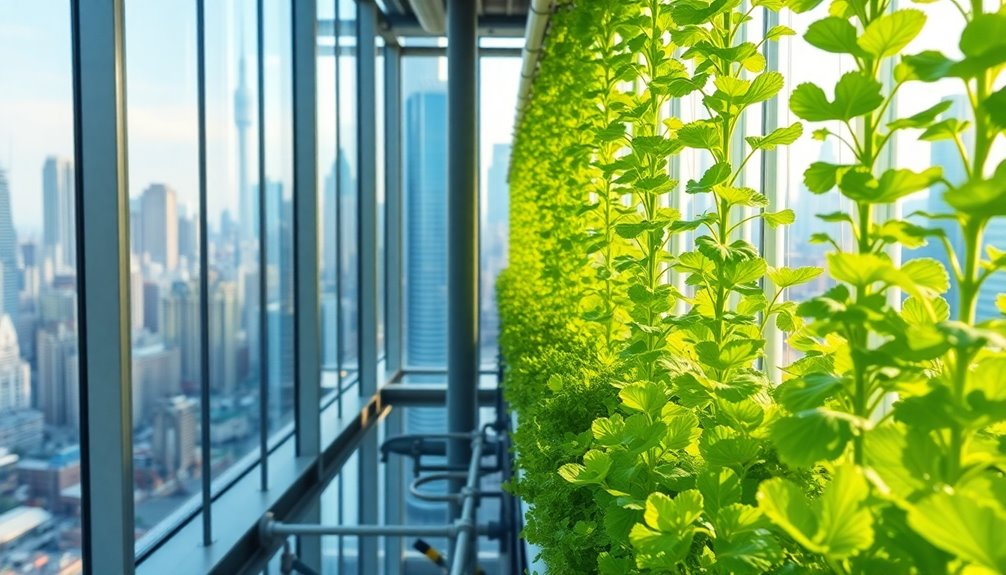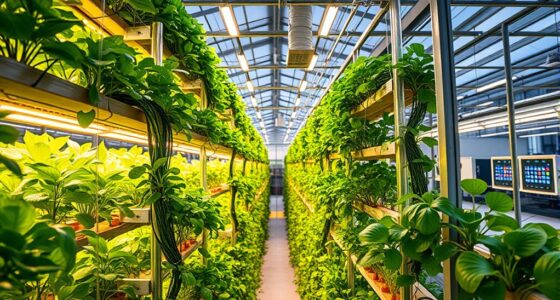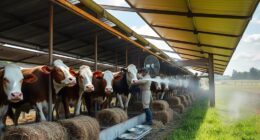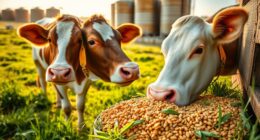Terrace farming is an innovative technique that turns sloped land into flat, stepped surfaces for agriculture. By creating these terraces, you maximize your arable land and greatly boost your crop yield, sometimes by as much as 44.8%. This method reduces soil erosion and manages water runoff efficiently, which is essential in hilly regions. Plus, it enhances soil moisture and supports biodiversity, making it a sustainable choice for modern farming. If you're curious about the different types and benefits of this method, you won't want to miss the insights coming up next.
Key Takeaways
- Terrace farming creates flat, stepped levels on slopes, maximizing arable land in hilly and mountainous regions.
- This ancient technique enhances agricultural productivity while combating soil erosion and water runoff.
- Various types, like broad-base and contour terraces, cater to different slope conditions and improve resource management.
- Benefits include significant increases in crop yields and soil moisture, supporting biodiversity and food security.
- Community engagement and modern technology are driving the adaptation of terrace farming for sustainable practices and climate resilience.
Definition of Terrace Farming
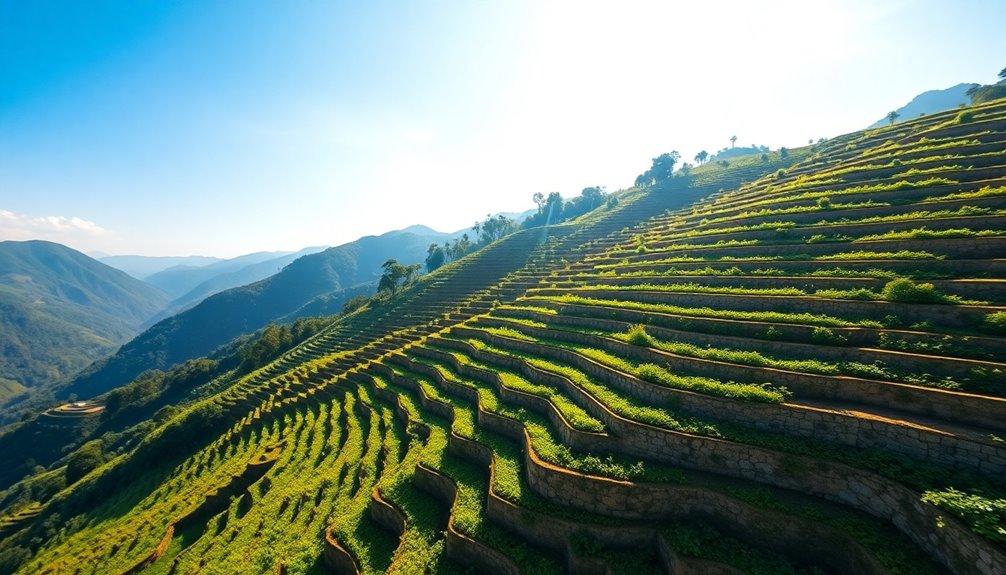
Terrace farming is an innovative agricultural practice that creates flat, stepped levels on sloped terrain, making it easier for you to cultivate crops and manage water flow effectively.
This method maximizes arable land in areas where traditional farming isn't feasible, particularly in hilly or mountainous regions. By building terraces with retaining walls, you can markedly reduce soil erosion and enhance soil retention, promoting better water conservation.
With proper techniques, this sustainable agriculture approach allows you to grow various crops such as rice, wheat, and vegetables, depending on your region's climate.
Ultimately, terrace farming contributes to food security, ensuring you can produce enough food in challenging environments while protecting the soil for future generations.
Historical Context of Terrace Farming
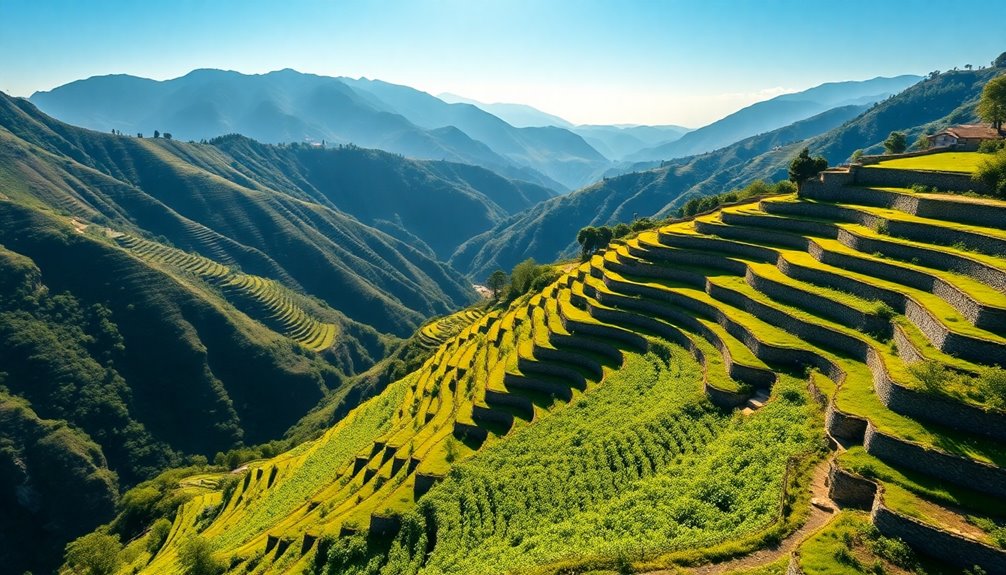
For thousands of years, civilizations around the world have turned steep slopes into productive farmland through terrace farming. Ancient civilizations, like the Incas and communities in China and the Philippines, mastered this technique to combat soil erosion and improve agricultural productivity in hilly areas.
By transforming unusable slopes into fruitful fields, they greatly improved food security, allowing them to grow staple crops such as rice, wheat, and barley.
- Developed in response to environmental challenges
- Integral for sustainable agriculture practices
- Enhanced water management techniques
- Contributed to the fertility of the soil
- Influenced modern agricultural methods
Today, many communities are reviving these ancient practices to guarantee food security while facing contemporary agricultural challenges.
Types of Terraces

When it comes to maximizing agricultural productivity on sloped land, various types of terraces offer unique advantages tailored to different environments and farming needs. Here are some key types:
| Type of Terrace | Key Features |
|---|---|
| Broad-Base Terraces | Suitable for gentle slopes (up to 8%); machinery access |
| Grassed Back-Slope Terraces | Prevents soil erosion; utilizes moved soil |
| Narrow-Base Terraces | Designed for steeper slopes; efficient in limited soil |
| Bench Terracing | Series of steps; ideal for water retention |
| Contour Terracing | Follows natural land contours; reduces soil erosion |
Choosing the right terrace type not only enhances agricultural output but also aids in water retention and minimizes soil erosion, making your farming efforts more sustainable and productive.
Terrace Farming Systems
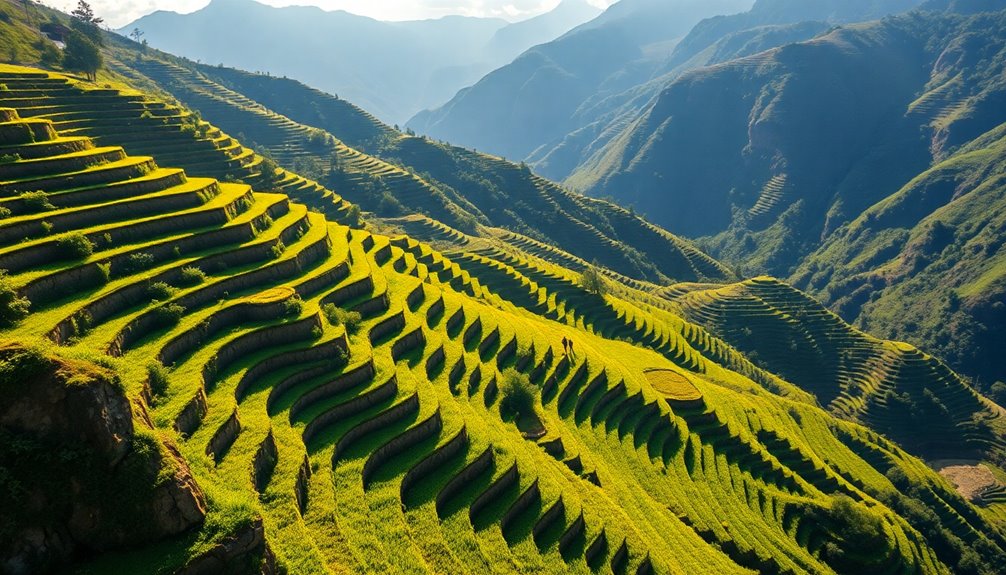
Effective terrace farming systems are vital for optimizing agricultural practices on sloped terrains. By implementing various terrace layouts, you can enhance soil conservation and water retention while minimizing soil erosion.
Here are five effective systems to take into account:
- Bench Terracing: Ideal for crops like rice, it enhances soil moisture levels.
- Contour Terracing: Follows land contours, efficiently managing water flow.
- Parallel Terracing: Requires land leveling but can be labor-intensive and costly.
- Broad-Base Terraces: Suitable for gentle slopes, maximizing agricultural productivity.
- Narrow-Base Terraces: Efficient for steep inclines, retaining soil and water effectively.
Choosing the right system is essential for improving your farming practices and ensuring sustainable land use.
Benefits of Terrace Farming
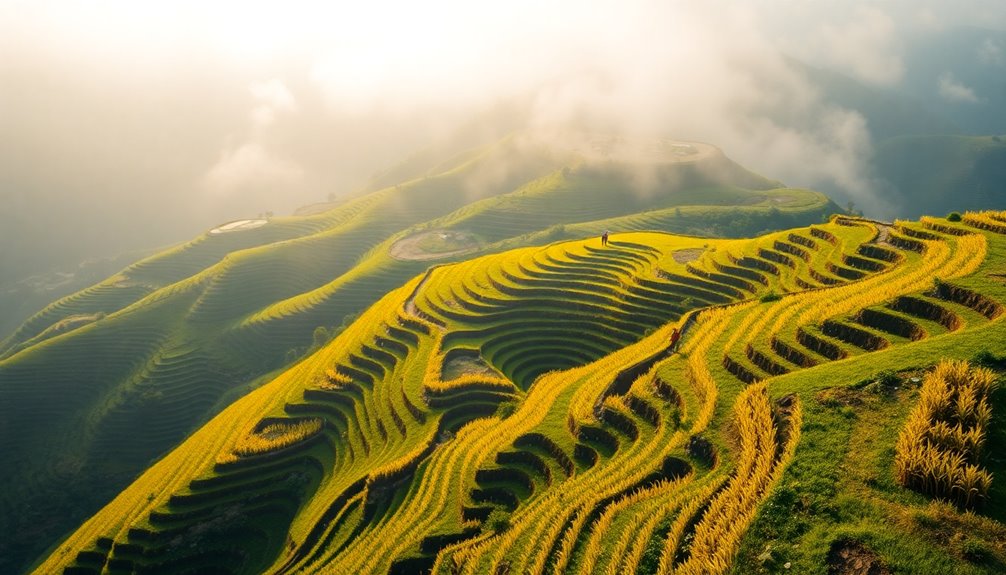
Implementing terrace farming not only optimizes agricultural practices but also brings numerous benefits that enhance sustainability and productivity.
By reducing water runoff by over 41.9%, this technique effectively manages water resources on sloped land, which is essential for conserving water. It also decreases soil erosion and sediment loss by 52%, contributing to better soil health and water quality downstream.
With terrace farming, you can boost agricultural productivity by enhancing grain yields by 44.8%. Additionally, it improves soil moisture content by 12.9%, promoting healthier crops and resilience against drought conditions.
Finally, this innovative method supports biodiversity conservation by creating varied habitats, fostering diverse ecosystems on your cultivated slopes, ensuring a thriving agricultural environment.
Environmental Advantages
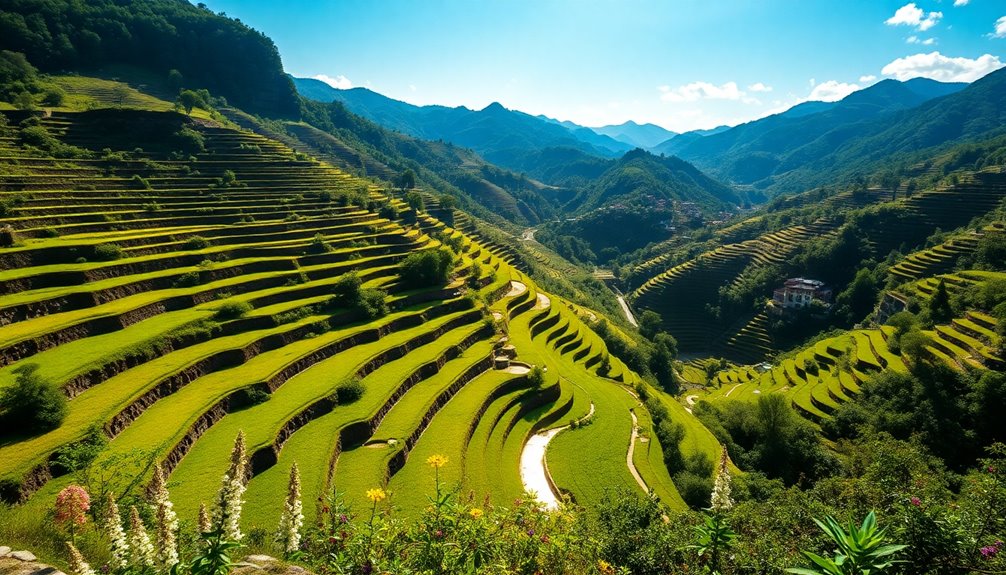
Terrace farming offers remarkable environmental advantages that greatly enhance land management in sloped areas. By implementing this technique, you can considerably reduce soil erosion and sediment loss, preserving valuable topsoil.
It also improves water retention, allowing for better moisture content in the soil, which is essential for crop growth in challenging terrains.
Here are some key benefits:
- Reduces water runoff by over 41.9%
- Minimizes soil erosion, decreasing sediment loss by approximately 52%
- Enhances soil health, supporting fertility and crop yields
- Promotes biodiversity by creating varied habitats
- Contributes to sustainable land use, improving environmental health
Embracing terrace farming not only boosts productivity but also fosters a healthier ecosystem, making it a win-win for both you and the environment.
Economic Aspects of Terracing

Investing in terrace farming can transform the economic landscape for farmers in hilly regions. While the initial construction requires a significant outlay, the long-term economic benefits are remarkable.
Terrace farming leads to improved soil retention, which helps you combat soil erosion and reduces costs related to fertilizers over time. You can expect an impressive increase in crop yields, with reports of grain yields rising by about 44.8%. This boost not only enhances food production but also strengthens your income and food security.
Additionally, terrace farming allows for a variety of crops, mitigating financial risks tied to monoculture and market fluctuations. Overall, this innovative technique promotes sustainable agricultural practices, fostering healthier local economies and communities.
Challenges and Disadvantages
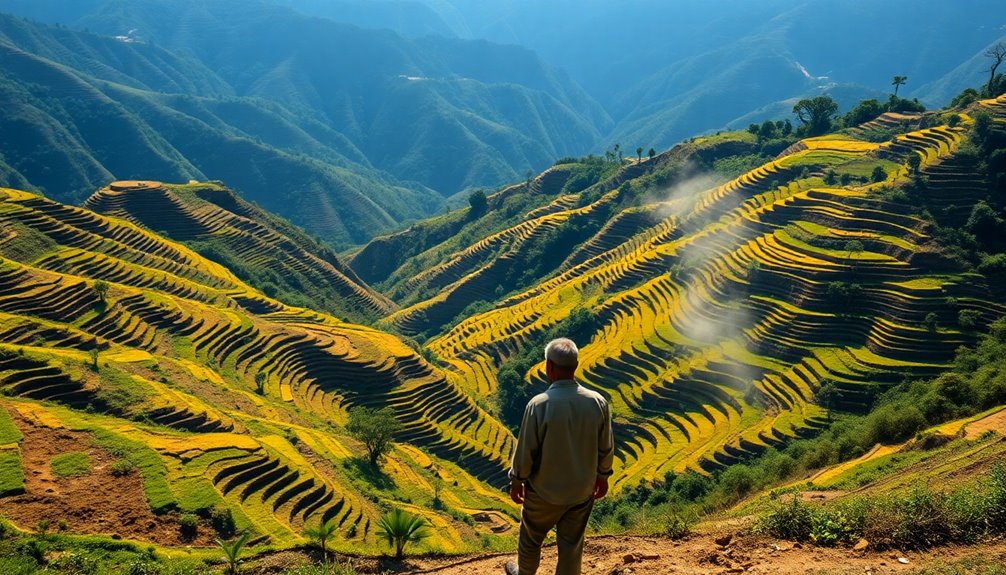
Despite the numerous benefits of terrace farming, several challenges can make it a formidable endeavor for many farmers. You might find that the high initial investment required for construction and materials can be a barrier, especially for smallholdings.
Additionally, the process is labor-intensive, demanding significant manual effort to maintain terraces and prevent soil erosion.
If maintenance is poor, you risk land degradation, while inadequate drainage can lead to waterlogging.
Furthermore, the complexity of designing and maintaining these systems requires specialized knowledge that may not be readily available to all farmers.
- High initial investment
- Labor-intensive maintenance
- Poor maintenance leading to soil erosion
- Inadequate drainage issues
- Need for specialized knowledge
Ecosystem Services Provided
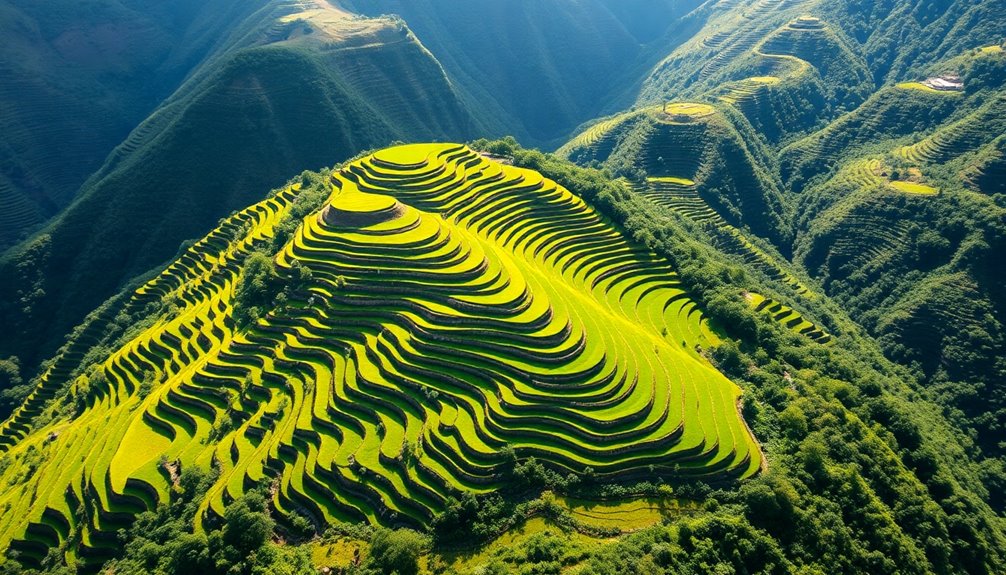
For centuries, farmers in hilly regions have relied on terrace farming to harness the land's potential while offering essential ecosystem services.
This innovative technique plays a significant role in water management by intercepting runoff, reducing its speed by over 41.9%, and enhancing soil moisture retention.
It also contributes to soil conservation, minimizing soil erosion and decreasing sediment loss by 52%, which helps maintain soil fertility.
By creating diverse microhabitats, terrace farming promotes biodiversity, supporting various plant and animal species.
Furthermore, it sustainably enhances agricultural productivity, improving grain yields by 44.8% and ensuring food security in these challenging landscapes.
Future of Terrace Farming
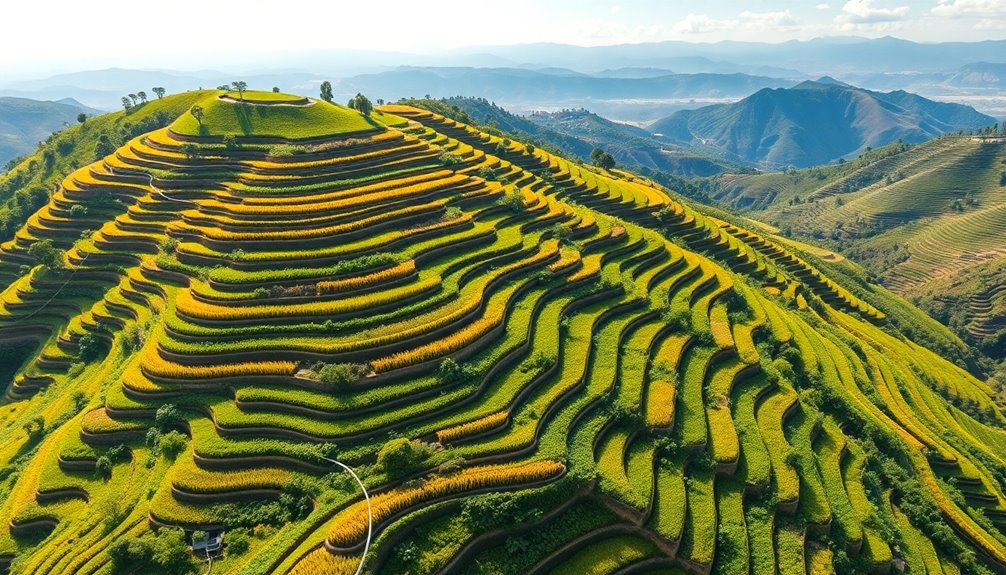
Terrace farming's role in promoting ecosystem services sets the stage for its promising future, where innovation and sustainability merge.
As you engage with this method, you'll see the integration of advanced technologies enhancing crop management and optimizing water usage. Innovations in soil health management, along with tailored crop varieties, will boost productivity against climate change challenges.
The rise of urban agriculture fosters renewed investment in terrace farming, particularly in land-scarce regions. Community-based initiatives and educational programs are essential for passing down knowledge and best practices.
- Advanced drone monitoring for precision farming
- Soil health improvements through bioengineering
- Tailored crop varieties for unique microclimates
- Increased focus on sustainable practices
- Enhanced community engagement in agricultural efforts
Frequently Asked Questions
What Is Terracing Farming Techniques?
Terrace farming techniques involve creating stepped levels on sloped land to improve water management and prevent soil erosion.
You can use various types, like broad-base and narrow-base terraces, tailored to your specific needs. This method helps retain moisture and supports crops effectively.
By building retaining walls and managing water flow, you enhance irrigation and drainage.
Regular maintenance is essential to keep your terraces productive and sustainable, ensuring you maximize your land's potential.
What Was a Benefit of Terrace Farming?
When it comes to farming, you can't judge a book by its cover.
One major benefit of terrace farming is its ability to greatly reduce water runoff, leading to better moisture retention in your soil. This practice not only enhances soil fertility but also boosts your crop yields by nearly 45%.
What Is the Meaning of Terrace Farming?
Terrace farming means creating flat, stepped levels on sloped land to grow crops effectively.
You're fundamentally transforming hilly areas into manageable fields, which helps prevent soil erosion and manage water flow.
This innovative method allows you to cultivate crops like rice, wheat, and fruits in places that wouldn't typically support agriculture.
Is Terrace Farming an Innovation?
Yes, terrace farming is definitely an innovation. It allows you to transform hilly or sloped land into usable, flat surfaces for agriculture, maximizing your land's potential.
This technique helps you manage water resources effectively, reducing runoff and soil erosion.
By utilizing modern tools like satellite monitoring, you can enhance efficiency and sustainability in your farming practices.
It's a smart way to increase food production while preserving the environment.
Conclusion
To sum up, terrace farming isn't just an ancient practice; it's a lifeline for modern farmers facing climate challenges. By maximizing your land's potential with this innovative technique, you can cultivate not only crops but also hope for sustainable agriculture. Just like your favorite smartphone, terrace farming adapts to its environment, making it a smart choice for the future. Embrace this method, and you'll contribute to a more resilient ecosystem while ensuring food security for generations to come.

